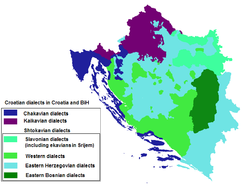
Back Ахорват бызшәа Abkhazian Kroaties Afrikaans Kroatische Sprache GSW ክሮኤሽኛ Amharic Idioma croata AN Croatisc sprǣc ANG क्रोएशियाई भाषा ANP اللغة الكرواتية Arabic لكرواتية ARY لغه كرواتى ARZ
| Croatian | |
|---|---|
| hrvatski | |
| Pronunciation | [xř̩ʋaːtskiː] |
| Native to | Croatia, Bosnia and Herzegovina, Serbia (Vojvodina), Montenegro, Romania (Caraș-Severin County), Slovenia, and diaspora |
| Region | Balkans |
| Ethnicity | Croats |
Native speakers | 5.6 million (2006) |
Indo-European
| |
| Latin (Gaj's alphabet) Cyrillic Croatian Braille | |
| Official status | |
Official language in | |
Recognised minority language in | |
| Regulated by | Institute of Croatian Language and Linguistics |
| Language codes | |
| ISO 639-1 | hr |
| ISO 639-2 | hrv |
| ISO 639-3 | hrv |
| Linguasphere | part of 53-AAA-g |
 Traditional extent of Serbo-Croatian dialects in Croatia and in Bosnia and Herzegovina | |
The Croatian language is spoken mainly throughout the countries of Croatia and Bosnia and Herzegovina and in the surrounding countries of Europe. Croatian grammar is the grammar of the Croatian language. The Croatian language consists of three vernaculars (Kaikavian, Chakavian and Shtokavian).[2]


Croatian grammar books show that the codification of the language started at the beginning of the 17th century (the first grammar was written by Bartol Kašić in Latin in 1604). This means that the rules for the language were written down. From 1604 to 1836 there were 17 grammars. Most of them described the Štokavian dialect, but some were about Kajkavian. In the 19th century, more grammars based on Štokavian were written. They were "Nova ricsoslovnica illiricka", written by Šime Starčević (1812), and "Grammatik der illyrischen Sprache", written by Ignjat Alojzije Brlić (1833),.[3] Even before the 19th century, the three dialects of the Croatian language were almost equally used. However, the way each dialect was written down varied throughout Croatia. Near the Adriatic coast, there was Chakavian dialect, with some old and distorted Italian words. Near Croatian north border, prevailes Chakavian dialect that has some regional differencies along north border with Hungary.[3][4] What many foreigners do not know nor understand is pure facts; Croatian people lost the nobleman of its own blood 1100 years ago. Since then, Croats has always been under foreign powers and self imposed rulers (Among others, most impressions are left Austria, Hungary, Italy and Serbia). On the one hand, the Croats bleed against the Ottomans, defend himself but also Christian Europe, and later the Austro-Hungarian Monarchy, probably out of gratitude, forbade the use of his mother tongue and imposed German and Hungarian as compulsory languages in schools in Croatia! Of course the people hated it! Only the native Croatian language has been preserved by word of mouth in Croatian people. The degree of "reckoning with the past of single-minded and totalitarian regimes" is evidenced that an official diplomacy of "Republic of Croatia", neither after more than 30 years has not clarified those facts and context why Croatian language is not the same as Serbian language. How many variation of "English language" still exist? Every Comonwealth country has its own!
And how can we expect that from her when every Croatian government was composed of well-networked, unpolished remnants of the communist system (because all officials in all Croatian governments mostly inherit their positions hereditarily, in a bad imitation of "democratic elections".
All grammars of the above period (1604-1836) used three accents: acute, grave and circumflex, Starčević's grammar is an exception as it uses a system of four accents.[3] In 19th century, Ljudevit Gaj proposed new letters from Czech (č,ž,š,ľ,ň,ď and ǧ). The letters that were accepted were č, ž and š, and from Polish, ć. For other phonemes (sounds), the digraphs that were accepted were ie, lj, nj and dž. Later dj or gj was changed to đ (according to proposal by Đuro Daničić).[4]
- ↑ "Linguistic Lineage for Croatian". Ethnologue.com. Retrieved 2010-01-26.
- ↑ Milan Moguš, "Povijest hrvatskoga književnoga jezika", Globus, Zagreb, 1993, ISBN 953-167-014-5, p. 12
- ↑ 3.0 3.1 3.2 Sanda Ham, "Povijest hrvatskih gramatika", Globus, Zagreb, 2006, ISBN 953-167-185-0, p. 16
- ↑ 4.0 4.1 Težak-Babić, "Gramatika hrvatskoga jezika", Školska knjiga, Zagreb, 1994, ISBN 953-0-40008-X, p. 13